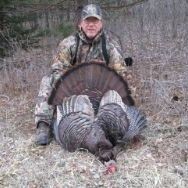Waterfowl serve as reservoirs for avian influenza
-
Similar Content
-
-
Your Responses - Share & Have Fun :)
-
.thumb.jpg.5c1a86e9339e49e53f5bfefed2220054.jpg)
By LakeofthewoodsMN · Posted
On the South Shore... The focus for many this week is the ongoing deer hunting season which is a big tradition in these parts, even for avid walleye anglers. There were some that either already harvested their deer or are more into catching fall walleyes than hunting. Those that are fishing are taking advantage of the unseasonably warm weather and excellent walleye and sauger bite that is happening across the lake. Cold weather is in the forecast in the upcoming days and weeks so that is also getting many excited. The best depths on the south end of LOW are 22-28 feet of water. Vertical jigging with frozen emerald shiners is catching most of the walleyes, saugers and jumbo perch. Depending upon where on the lake you are fishing, some slots and big trophies are in the mix as well, but most reports are talking about good numbers of eaters. Jumbo perch are coming in good numbers this fall which will serve ice anglers well. Watch out for an occasional pike or even lake sturgeon mixed in with the walleyes. There are good numbers of walleyes and saugers across the south shore which is setting up nicely for early ice. On the Rainy River... There continues to be good numbers of shiners in the river, and consequently, there are good walleyes in the river as well. Walleyes along with saugers, pike and some sturgeon are coming in up and down the river. Most walleyes are being caught in 10-25 feet of water in various stretches of the river. Jigging with live or frozen emerald shiners is the key. Some anglers are also still slow trolling crankbaits upstream to cover more ground and find fish. Both methods are producing solid results. Sturgeon fishing remains strong. The catch-and-release sturgeon fishing is open into the spring when it changes to the "keep season" on April 24th. Up at the NW Angle... As temps are getting colder, most are in the woods hunting and not fall fishing, however, for those who bundle up, fishing continues to be excellent. A nice mixed bag with walleyes, saugers, perch, pike and crappies being caught. Very good muskie fishing with the colder water temps and shorter days. Some big fish and some good numbers are being caught amongst the islands. Both casting and trolling is getting it done. -

By gimruis · Posted
I hunt in the rifle zone so I don't have a need to use a shotgun to hunt deer, but I would be looking at this if there was ever a need to. There could be state legislation introduced next summer that eliminates the shotgun zone completely. It has bipartisan support. Wisconsin removed theirs years ago and MN is usually later to follow. They've tried to pass it more than once and it came up just short both times. Probably just a matter of time. -

-

By leech~~ · Posted
Screw that, here's whatch need! 😆 Power-Shok Rifled Slug 10 Gauge 766 Grain Grain Weight: 766 Shotshell Length: 3-1/2in / 89mm Muzzle Velocity: 1280 -

By Wanderer · Posted
20 ga has become a real popular deer round in the last 5 or so years. The rifled barrels are zinging those sabot slugs with rifle like accuracy out to 100 yards easily. Some go so far as dialing in for a 200 yard shot but really, by 150 they’re falling off pretty low. I have a single shot Ultraslug in 20 ga that shoots really well at 100 yards. Most everyone I know that has bought a slug gun lately has gotten the Savage 220 in 20ga. Problem can be finding the shells you want. -

By leech~~ · Posted
My son always bugs me about getting a nice light over-under 20ga for grouse hunting. I say Heck no, I'm getting a 3 1/2" 10ga so I can put as much lead in the air that I can!! So, I'm keeping my 12ga. -

By 11-87 · Posted
That’s almost exactly what I was thinking. Have slug barrels for both One for turkey and one for deer. I have a 20ga mosseberg as well. (Combo came with the scope but never used. I always liked the 12 better -

By leech~~ · Posted
Wanderer is right on the money and covered it well. I was wondering too if you had a slug barrel for one of your guns? If so you could make that your slug gun with a scope, and the other your turkey gun with the Red dot. As you can afford it. -

By Wanderer · Posted
Kinda depends on if you want magnification or quick target acquisition. More magnification options and better accuracy with a scope. You get what you pay for too so get comfortable with a budget for one. Tasco and Bushnell work but I find they lose their zero easier, have low contrast and don’t gather light well in low light conditions. That said, I’m still using one I haven’t replaced yet. Vortex has been the hot brand for the past several years for bang for the buck. Good products. Nothing beats Swarovski though. Huge dough for those. Burris is another decent option. There are some specific models for shotgun/slug hunting in the economy brands and bullet drop compensation (BDC) reticles. Based on experience I’d recommend not falling for that marketing ploy. Red dots are usually lower magnification and easier to get on target. Reasonably accurate but don’t do well with definition, like searching the brush for your target. I put a HAWKE red dot on a .22 for squirrels and it’s been good. For turkey, that’s probably the route I’d go. If your slug shots are normally not too far and too brushy, I’d think a red dot could work there too if you’re only buying 1 scope. You’ll be better off dimming the reticle to the lowest setting you can easily use to not over shine the target and get a finer aim point. If you don’t have a slug barrel, you might appreciate one of those. I had a browning with a smoothbore slug barrel that shot Brenneke 2-3/4 inch well. The 11-87 would well fitted with a cantelever rifled barrel. -

By 11-87 · Posted
Looking for recommendations on scope or red dot I basically hunt turkey and whitetail, live in southern MN. So it’s all deer/ shotgun looking to add a scope/ red dot as my eyes don’t work like they used to to with the open sights. my gun options are 11/87 12. Browning BPS 12 not looking for the most expensive or the cheapest pros and cons of one over the other
-


Recommended Posts
Join the conversation
You can post now and register later. If you have an account, sign in now to post with your account.
Note: Your post will require moderator approval before it will be visible.